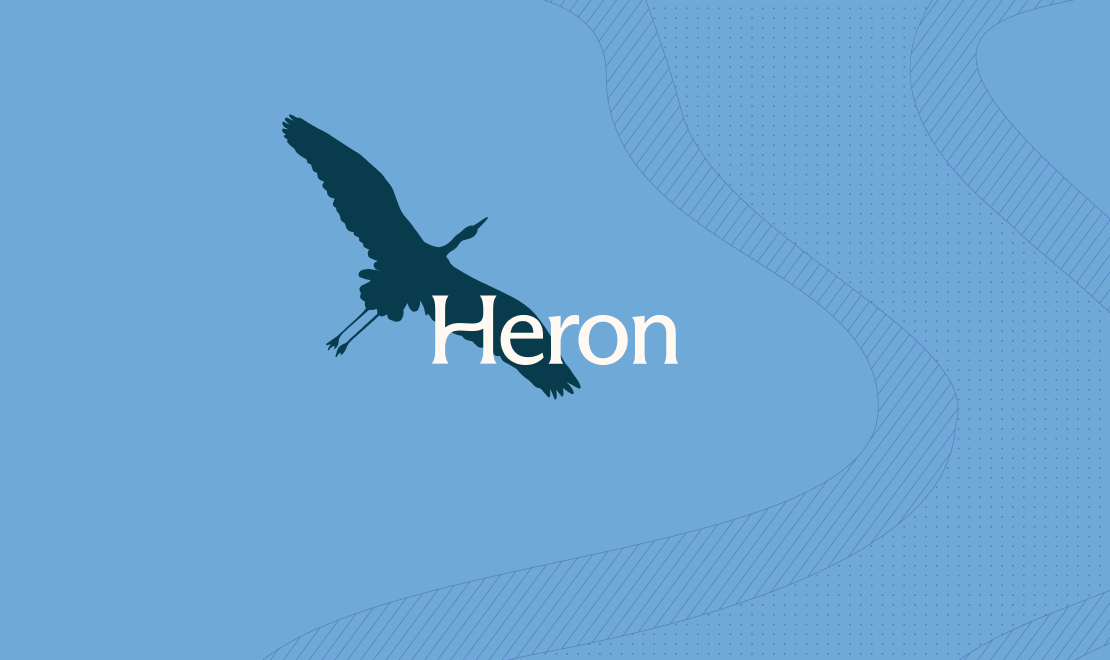Heron Finance’s 2% Management Fee Explained
Many investors have been asking what our 2% management fee covers. This articles explains why we charge a 2% fee, and compares how our 2% fee stacks up with the fees of other investment products.

Heron Finance often gets mistaken for a credit fund. We are not a credit fund–we are an investment platform that builds diversified portfolios of private credit deals for accredited investors. That is very different from investing in a credit fund, which typically (though not always) originates a single portfolio of deals.
Users on Heron Finance can actually invest in multiple credit funds. And the investments are automated–meaning users don’t have to constantly rebalance their capital. Our system does that for you, according to your stated financial goals and risk tolerance.
There is one other key differentiating factor between Heron Finance and the typical credit fund: our compensation structure. Heron Finance collects a 2% management fee. That is the only fee we charge users–there are zero additional costs to use our platform.
Some users might wonder what our 2% fee covers. In this article, we’ll dive into our management fee and explore the services it supports. We’ll also compare and contrast our compensation structure with that of typical private credit funds, index funds and traditional registered investment advisors (RIAs).
Key Highlights
- The Heron Finance management fee covers the expenses associated with partnering with credit funds, monitoring the deals on our platform, rebalancing user portfolios and maintaining the technology and user interface.
- Heron Finance’s management fee is higher than the management fee of some competing investment products–but our platform charges no carried interest, which makes our total expected returns higher than those of competitors.
- Private credit is a burgeoning asset class that individual investors traditionally could not access. Total expected returns are higher than those of the stock and bond markets, hence investors should not be scared off by the management fee (especially when that is the only fee our platform charges).
What Does the Heron Finance Management Fee Cover?
The most obvious answer here is the management of our platform. But that’s a bit too high-level. Let’s dive in the weeds to explore what exactly Heron Finance investors are getting for their 2% fee.
- Credit selection: Someone has to identify and aggregate the deals on our platform. Our experienced credit team (over $4 billion in deal originations) leverages their robust network of credit professionals to partner with experienced credit fund managers. These partnerships enable us to provide a range of private credit deal types to investors. Our credit team acts as a funnel, selecting credit funds with the most creditworthy deals to feature on our platform. Accredited investors can easily invest in those funds–many (if not all) of which would be inaccessible without the benefit of our platform. Read more about how we curate investments here.
- Platform management: Heron Finance is built atop innovative technology, including the blockchain. A team of brilliant engineers works tirelessly to ensure that our platform’s functionality and user interface are seamless and intuitive. This includes everything from generating smart contracts for financial transactions, to facilitating deposits and withdrawals. Read more about our reliance on blockchain here.
- Automatic Rebalancing: Heron Finance offers a ‘set it and forget it’ investment experience. Simply select a strategy and fund your account, and we’ll take care of the rest. That includes building you a diversified portfolio of private credit deals and automatically reinvesting the interest accrued on individual deals so users benefit from compounding interest. We also continuously monitor your portfolio as deal allocations change over time (thanks to said interest compounding), and periodically rebalance your portfolio according to your stated financial goals and risk tolerance. Please see our Wrap Fee Brochure for additional information.
All of the above is covered in the 2% management fee. Toss in the operational expenses of running a business, and you can see the need for platforms like ours to charge a management fee.
How Does Heron Finance’s Compensation Structure Stack Up?
Now that you understand what the 2% fee covers, let’s examine how it compares to other options out there.
Private Credit Funds
The typical management fee for private credit funds ranges from 1% to 2% of committed capital or invested capital, depending on the fund's strategy and stage (some exceptions exist, such as tiered fee structures based on fund size or leverage levels).
At first glance, you might be thinking ‘hey, 1-2% - that means Heron Finance is at the higher end of the comp spectrum!’ Well, not so fast. You see, credit funds also charge what’s called ‘carried interest’ in addition to their management fee. Carried interest means the fund collects an additional percentage of the annual profits (typically 15-20%), above a certain hurdle rate.
For example, say you were to invest $10,000 into a credit fund with a 1% management fee, a hurdle rate of 7% and a carried interest of 20%. If the fund produces a 15% annual return, that’s $1,500 in profit.
But you, the investor, don’t get the entire $1,500. First you have to subtract that 1% management fee. 1% of $10,000 = $100.
Next, you have to calculate the carried interest. The hurdle rate is 7%. And 7% of $10,000 = $700. That means the carried interest kicks in after $700 of profit is accrued–or on the remaining $800 of profit.
20% of $800 = $160.
Add the $100 management fee, and you get a $260 annual fee to invest with this credit fund. Meaning your annual profit is $1,240 ($1,500 - $260).
Heron Finance charges users a 2% annual management fee. So if you were to invest the same $10,000 on Heron Finance, and we produced the same 15% annual return, your profit calculation would look like this:
15% of $10,000 = $1,500
2% of $10,000 = $200
Annual profit = $1,300
So you can see, even though Heron Finance charges a 2% management fee, and the sample credit fund charges a 1% management fee, your annual profit is higher with Heron Finance thanks to the carried interest, which our platform does not charge.
RIAs
The typical fee for an RIA is 1-2%. Again, at first glance, it seems like Heron Finance is expensive in comparison. But many RIAs have performance fees (similar to the carried interest of credit funds). These performance fees usually range from 10-20%.
Also, the average RIA is investing across a basket of assets (stocks, bonds, ETFs, mutual funds, etc.), meaning their long-term return expectations are typically in the 5-8% range. Heron Finance, in contrast, is targeting an APY of 10-14% net of all fees.
Some RIAs also work on a commission basis, and earn income from selling investment products like mutual funds, annuities, etc. This mis-alignement of incentives can significantly increase the overall costs for clients, and is definitely something investors should consider when they go shopping for RIAs.
Index Funds
The typical index fund charges 1% or less in annual fees. There are also no performance or carried interest fees.
So on management fee alone, index funds win out. Hands down.
But remember, the fee is subtracted from your annual return. So it’s the overall return that matters most–not the fee. Some prominent hedge fund managers are able to charge upwards of 30% performance fees. And big-money institutional investors are lining up to pay those fees, on the theory that 70% of that hedge fund’s returns are superior to 90+% of most other investor’s returns.
So the total annual return is all that should matter. Keeping this in mind, let’s circle back to index funds. Stock market index funds average 10% annual returns (bond market indexes average even less). Subtract a .5-1% management fee, and you're left with a 9-9.5% total annual return for stock index funds.
Heron Finance charges a 2% management fee, but we are targeting a 10-14% annual return. And that annual return is net of fees. Meaning we’ve already excluded our 2% management fee from that return target (without the fee, we’re targeting 12-16% annual returns).
Not only are we targeting higher returns than stocks and bonds, but private credit produces much less volatility than both. The S&P has had 7 negative return years over the past 34. Meanwhile, the median private credit fund manager has never had a down year. Check out private credit’s returns over the years when the S&P fell:
In 2022 alone, the S&P 500 dropped 19%, and the NASDAQ plummeted 33%. And the bond market fared even worse–Intermediate-term Treasury bonds lost 10.6% for the year, and long-dated (30-year) Treasury bonds plunged 39%–the most since 1754!
This is what investors mean when they say that ‘private credit smoothes out a portfolio’s volatility.’ The return profile is such that private credit is much less likely than stocks or bonds to produce a down year, therefore smoothing out a portfolio’s overall volatility picture.
Summing Up the Management Fee
Heron Finance targets a 10-14% APY net of all fees. That means we’re targeting a total return of 12-16%, minus Heron Finance’s 2% management fee. 10-14% APY is a higher return than the stock and bond markets have historically provided (of course, investment in private credit also comes with a higher degree of risk. Read more about the risks of investing in private credit here).
And given that we’re the first robo advisor exclusively focused on private credit, our clients can finally gain access to an asset that has historically been less volatile than stocks and bonds, and can have their investments automated (meaning our platform will automatically allocate and re-invest for you, taking the work and stress out of investing).
For all of these reasons, we feel that our 2% management fee is well worth the cost. Additionally, when we stack our management fee up against those of our competitors, we believe the value that Heron Finance provides exceeds that of the typical private credit fund, RIA and index fund.
All of that said, we welcome your questions about our management fee (or anything else)! Feel free to email us at: [email protected]
And if you’re an accredited investor and would like to get started on Heron Finance today, click the button below to begin investing in a diversified portfolio of private credit deals.




